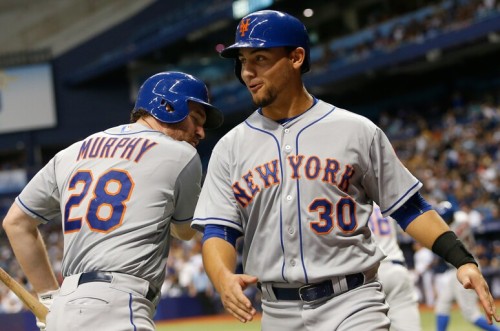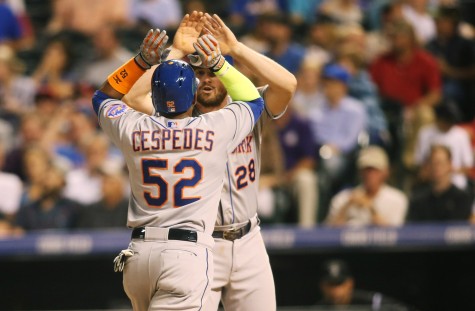
To say that the Mets offense was bad in the first half of the season would be an understatement. The Mets crawled into this year’s All Star Break ranked 28th in runs and dead last in batting average. According to Baseball Prospectus and FanGraphs, the Mets were actually lucky to be a high as 28th in runs – and with a slash line of .233/.298/.363, those outlets were probably right.
But then something miraculous happened. It wasn’t immediately after the All Star Break, which took place from July 13th to 16th, but shortly thereafter. The Mets began to get healthy and make some moves.
 On July 24th, the Mets made their first move, promoting fast-rising prospect Michael Conforto directly from Double-A; later that day, they acquired veterans Juan Uribe and Kelly Johnson from the Braves, applying a tourniquet to a flagging lineup and bolstering their eventual bench; a week later, on July 31st, team leader Travis d’Arnaud made his anticipated return to the lineup; while earlier in the day the Mets added a bonafide star in Yoenis Cespedes, who currently sits 7th in MLB in WAR (5.6) and is having close to an MVP-caliber season.
On July 24th, the Mets made their first move, promoting fast-rising prospect Michael Conforto directly from Double-A; later that day, they acquired veterans Juan Uribe and Kelly Johnson from the Braves, applying a tourniquet to a flagging lineup and bolstering their eventual bench; a week later, on July 31st, team leader Travis d’Arnaud made his anticipated return to the lineup; while earlier in the day the Mets added a bonafide star in Yoenis Cespedes, who currently sits 7th in MLB in WAR (5.6) and is having close to an MVP-caliber season.
The Mets Are Red-Hot in August
Since acquiring Cespedes on July 31st, the Mets are a blistering 15-6, thanks in part to an offense that has averaged 5.75 runs per game. Their turnaround is astonishing. They’ve batted .277/.337/.510 in August, and their 38 home runs is first in the league, dwarfing the National League average of 23.7. This would be impressive for any team, but for a team that could barely hit its weight only a month ago, it’s appears to be nothing short of a miracle.
So who are these Mets, who yesterday welcomed back their Captain, David Wright? Are they on a temporary hot streak, or is this offense one of the most dangerous in the National League? The answer, as usual is a little of both, as a little luck, some bad opposition, and some substantial improvements to the lineup have all contributed to their surge. But ultimately, there can be no doubt – the Mets offense can be one of the best in the National League.
The Mets Haven’t Been Overly Lucky
The Mets have had a little luck in August, but nothing that would make you stop and say that it’s all a mirage. The team’s BABIP, which is .286 for the season, has risen to .319 in August. Part of that rise in BABIP, however, can be credited to a 37.2 Hard Hit %, which is highest in MLB by a large margin this month. Also helping matters is a 17.4% HR/FB ratio, up from 11.1% on the year overall.
As you might guess, much of the improvement in the underlying components can be credited to simply having better players, like Yoenis Cespedes (average fly ball distance of 294 feet), Michael Conforto and Juan Uribe, each of whom have home runs of over 430 feet as Mets. The Mets have simply been hitting the ball harder and have been rewarded for it.
The Schedule Hasn’t Been That Easy Yet
As we mentioned, the Mets have had a somewhat soft schedule in August, having played 7 games against teams above .500 (Nationals, Pirates, Orioles), 3 against the Rays who sit at .500, and 11 games against teams thoroughly out of the race (Marlins, Rockies, and Phillies).
The Mets offense has faced some legitimate pitching in that time, with the Pirates (2), Rays (9), Nationals (11) and Orioles (14) all ranking in the top half of MLB in pitching, however the bulk of the damage has been done against bad teams. The Mets scored 60 runs in only five games against the Marlins, Rockies, and Phillies, but even without those blowouts, they have averaged 3.81 runs per game in the other sixteen contests.

The Improvement Is Very Real
So if it’s not luck, and it’s not an extraordinarily easy schedule, can Mets fans bank on the fact that this is a legitimate improvement? In a word: yes.
In the first half this year, the Mets gave plate appearances to the following players: Michael Cuddyer (303), Kevin Plawecki (175), Eric Campbell (163), John Mayberry (104) and Darrell Ceciliani (75) to name a few. These players combined to hit .220/.287/.329 over 927 plate appearances, good for a wOBA of .273, a wRC+ of 74, or an OPS of 617 depending on what stat you prefer.
These players have been replaced directly by the Mets new additions (e.g. Wright for Campbell). The rest of season projections for Wright, Cespedes, and d’Arnaud are a staggering improvement, with a combined projected line of .270/.329/.467, good for a wOBA of .341, a wRC+ of 120 and an OPS of 796.
* Warning, gory mathematical details ahead *
In order to determine the approximate difference between the two lineups in terms of runs, I looked at Runs Created, a statistic which can be used to estimate how many runs a hitter contributes to his team. As the object of the game is to score runs, and there are a finite number of ways to do it (hits, walks, stolen bases, not striking out, etc.) you can get a pretty good idea of how many “runs” a player has added to your team’s output.
So far in 2015, the Cuddyer, Plawecki, Campbell, Mayberry and Ceciliani combination only managed to “create” 77 runs of offense over 865 at-bats, which is good for approximately 3.08 runs per game. This is about in line with what we might “expect” from a full lineup if it performed as poorly as those five.
The Cespedes/Conforto/Wright/d’Arnaud group, on the other hand, with their 120 wRC+ projection, could be expected to produce similarly to what a Todd Frazier (121 wRC+), Justin Upton (121 wRC+) or Kole Calhoun (119 wRC+) have done this year. Those three players have produced a total of 209 runs created in 1380 at bats, which is good for about 5.54 runs per game.
* Gory mathematical details ended *
The analysis doesn’t end there, however, as only some of the spots in the Mets lineup have been improved, while the rest are holdovers from earlier in the year. Luckily, the remaining incumbents (primarily Granderson, Duda, Murphy, Flores, Tejada and Lagares) have performed well this year with a combined .263/.326/.422 line and a 108 wRC+. These players have combined for approximately 4.87 runs per game, which is an excellent figure when you consider it includes our shortstop, second baseman, and struggling centerfielder.
By replacing three of the weakest links in the lineup with three star-caliber players, the Mets are clearly much improved from what we saw at the start of the year. How improved? Well, accounting for the pitchers slot in the lineup (but not for pinch hitters, etc.) the Mets offense has improved by almost a full run per game, from 3.74 runs per game to 4.56 runs per game. For context, an average of 4.56 runs per game would be 2nd in the National League behind only the Arizona Diamondbacks.
This improvement in the lineup is even larger when you consider the better use of platoons and a deeper, more useful bench. That depth was on display last night against the Phillies — and may have won the Mets the game — as d’Arnaud worked a critical walk batting eighth and the Mets were able to pinch hit Cuddyer for the game’s decisive hit.
The Mets offense is suddenly for real, and is not just the result of luck or an easy schedule. If the Mets can continue to pitch like they have so far this season, they might be equipped to make a real run.















